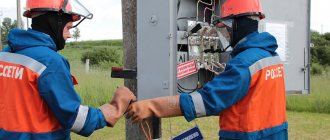On January 1, 2022, a number of electrical safety rules came into force, including new rules on labor protection during the operation of electrical installations, approved by Order of the Russian Ministry of Labor dated December 15, 2022 N 903n.
The rules canceled the order of July 24, 2013 N 328n. The new electrical safety rules will be in force for five years, until December 31, 2025 inclusive. Article navigation
- Comparative table with changes to the new rules on labor protection during the operation of electrical installations
- Rules for labor protection during the operation of electrical installations 2022: what has changed
- What should an occupational safety specialist take into account when working under the new rules: current challenges
New rules on labor protection during the operation of electrical installations (Order of the Ministry of Labor dated December 15, 2020 No. 903n)
Safety training, unscheduled briefings and inspections
Preparation of the workplace and work permitted in the order of routine operation to be performed by operational or operational-repair personnel applies to electrical installations with voltages up to 1000 V and is performed only on the equipment (area) assigned to these personnel or in an electrical installation up to 1000 V of the consumer in accordance with paragraph 42.8 Regulations Work in the order of routine operation, included in the list of works, is permanently permitted, for which no additional instructions, orders, or targeted training are required.
Enacted by Order 328n, the document covers in detail the rules for safe work with various electrical equipment and tools, for example, lighting fixtures and electric hand tools. The provisions of the new Rules take into account the use by workers of modern means of information transmission, control, and equipment modernization.
He is allowed to perform all types of work on electrical installations, including installation, commissioning, repairs and others. At the same time, depending on the set of tasks within this category of personnel, additional subcategories are distinguished, including administrative and technical, operational, maintenance and operational repair.
N 328н, which establishes labor protection requirements during work related to the operation of electrical installations.
Important! According to the 2021 Rules, all organizations (employers) whose work is related to electrical installations (electrical safety) must conduct an unscheduled knowledge test regarding occupational safety requirements. According to Decree of the Government of the Russian Federation No. 1580 dated 10/01/2020, the period for this inspection for heat supply facilities has been extended until 07/01/2021.
If the Consumer has the position of chief power engineer, the responsibilities of those responsible for electrical facilities are usually assigned to him.
It is necessary to organize training on the new rules for members of the commission to test knowledge of the rules of work in electrical installations. Such training and knowledge testing are carried out at the training center.
Group I electrical safety clearance does not require any complex skills: to obtain it, it is enough to be able to safely interact with basic types of equipment. Therefore, a simplified procedure has been established for assigning this group.
Rulebook structure
The document included two sections - main and appendices. The first contains all the information to ensure the safest operation of electrical equipment, as well as its characteristics and operating conditions.
First section
It is dedicated to the standards for the safe operation of electrical installations. All officials are required to navigate the set of rules and understand the document. In this regard, special attention should be paid to the chapters reflecting the following information:
- Ensuring the safe operation of electrical installations that are part of the country's energy sector.
- Degree of responsibility and responsibilities of performers.
- Features of the equipment acceptance process during commissioning.
- Requirements for service personnel, as well as methods for achieving a sufficient level of training.
Chapter 1.5 is devoted to energy management issues. It contains not only basic concepts with provisions, but also recommendations for the operational management of energy management.
Here you can also find recommendations for creating and maintaining automated control systems (ACS).
Standards for maintenance, repair and modernization of electrical installations and equipment equivalent to them are found in Chapter 1.6. Recommendations for compliance with environmental requirements can be found in Chapter 1.7.
Second and third sections
The second part of the document addresses issues related to the operation of general-purpose electrical equipment. Here performers can become familiar with the requirements for the safe operation of installations of this type, for example, transformers and power lines. These sections also list the indicators of metering equipment, surge protection and control.
The third section contains the basic rules for the operation of special-purpose electrical equipment. This type of electrical installations includes:
- Working in hazardous installation conditions.
- Power plants that are used by electricity consumers.
- Welding installations.
- Thermal equipment.
Chapter 3.6 discusses the rules for testing electrical installations.
Application Set
The main part is supplemented by a number of applications that contain information necessary to optimize document flow and operation of electrical equipment. Appendix 1 of the PTEEP is a sample application form for accepting all responsibility imposed on an official for violating the rules of operation of electrical equipment.
The following appendix regulates the timing and frequency of all stages of equipment diagnostics, and also contains the most important characteristics of installations for performing these works. Annex 3 should be used in conjunction with Tables 1 to 38. Here are the parameters that should be used by employees during testing.
Appendix 4 provides indicators of permissible limits for voltage increases, which invariably arise at the time of operational switching , as well as in emergency situations. The remaining applications are devoted to working with equipment used in hazardous environments. The set of rules ends with a short list of all terms found in PTEEP.
Labor safety rules for the operation of electrical installations in 2021
The list of works in the order of current operation must contain instructions defining the types of work permitted to be performed individually and by a team.
For official documents, please visit the official websites of the relevant organizations or official publications. Our organization and the site administration are not responsible for possible harm and/or losses arising or received in connection with the use of the documentation.
A work order for live parts was issued for one day, but the team did not have time to complete the entire scope of work. The next day you need to issue a new outfit.
The requirements for employees are described in more detail, with appendices and notes moved into the main text.
Rules for labor protection during the operation of electrical installations 2022: what has changed
Change 1. Work permit for work under voltage
Clause 6.3 of the new rules states that, as before, it is allowed to issue a work permit for a period of no more than 15 calendar days from the date of commencement of work. It can be extended once for a period of no more than 15 calendar days.
The new rules have added one more requirement for a work permit that cannot be missed: When performing live work on live parts of electrical installations, a work permit is issued for a period of no more than 1 calendar day (work shift).
The rules clarify that if it is necessary to perform work under voltage on subsequent days (work shift), it is necessary to issue a new permit.
Example:
A work order for live parts was issued for one day, but the team did not have time to complete the entire scope of work. The next day you need to issue a new outfit. Previously, it was possible to extend the outfit, now - issue a new outfit for each new day.
Change 2. New form of work permit
According to the new rules, the permit form is advisory in nature. You can be guided by clauses 6.25-6.31 of the new rules or use the old form, but add additional instructions, including an index of special work and groups of work at height.
Change 3. Assignment of electrical safety group I
In the old rules, the assignment of group I was carried out by an employee from among the electrical personnel who had group III in electrical safety, appointed by order of the head of the organization.
The new rules indicate that group I in electrical safety can be assigned to an employee from among electrical personnel who has group III in electrical safety or an occupational safety specialist who has group IV in electrical safety or higher, appointed by order of the head of the organization .
See the table for all changes to the new rules
“On approval of the Rules for the technical operation of consumer electrical installations”
Now let’s analyze the changes in electrical safety in 2021, which relate to the procedure for organizing training for employees of manufacturing enterprises. They are related, among other things, to the entry into force of new requirements of the listed regulatory documents.
Now the task of every occupational safety specialist is to bring the organization’s documents into compliance with the new standards and carry out a number of activities, briefings and training on occupational safety. We have prepared a step-by-step guide to help you.
The rules clarify that if it is necessary to perform work under voltage on subsequent days (work shift), it is necessary to issue a new permit.
Now the task of every occupational safety specialist is to bring the organization’s documents into compliance with the new standards and carry out a number of activities, briefings and training on occupational safety. We have prepared a step-by-step guide to help you.
When performing live work on live parts of electrical installations, a work permit is issued for a period of no more than 1 calendar day (work shift).
In cases where the work performer combines the duties of a permitter, he must prepare the workplace with one of the team members who has group III in electrical safety (except for the cases provided for in paragraph 42.5 of the Rules).
Key points important for an electrical safety engineer:
- The appointment of the person responsible for electrical equipment and his deputy is carried out on the basis of paragraphs. 1.2.3–1.2.5 PTEEP. The responsibilities of the person responsible for electrical equipment are specified in clause 1.2.6 of the PTEEP.
- An occupational safety engineer cannot be responsible for electrical facilities, since he is an inspecting person, and not electrical or electrical engineering personnel. Therefore, if there is no safety engineer on staff, his responsibilities cannot be assigned to the person who is already responsible for electrical equipment. It turns out that this person will have to check his own work, which is wrong. But responsibility for ensuring labor protection and fire safety in the department can be assigned to the person responsible for electrical equipment.
- Rules for labor protection during the operation of electrical installations are applied in all organizations that use electrical installations, electrical equipment, and power tools. Therefore, even if your organization uses only lighting fixtures, a computer and a kettle, you will still have to study in POTEU.
- Which electrical safety group which specialist needs to have is specified in Appendix 1 to the new POTEU as amended for 2021. The procedure for assigning these groups is also specified here. For example, to be assigned the 4th group, an occupational safety engineer, in addition to successfully passing exams and receiving the 3rd group, must have 3 or more years of production experience.
- Good knowledge of the requirements of POTEU and PTEEP by an OT engineer reduces the company's costs. For example, a contractor whose employees are trained in electrical safety group 2 should repair an excavator. This is an active electrical installation, so to carry out repairs, workers need to have electrical safety groups 3 and 4. However, if you make this electrical installation inoperative for the period of repair (disconnect the power cable, ground it, fill out the appropriate documentation), the 2nd electrical safety group will be enough to carry out the repair, and you will not have to spend money on additional training.
- The maximum electrical safety group that is allowed to be assigned to persons under 18 years of age is 2nd. The same group is assigned to practical students and interns. It is prohibited to include such workers in existing teams. The maximum that they can do as an exception is to act as a security post without entering a working electrical installation.
- The enterprise commission can confirm the electrical safety group and assign a new one. At the same time, she is allowed to confirm or assign a group no higher than the one that 3 members of the commission have. For example, if in the knowledge testing commission 3 people are trained in the 3rd group, they cannot assign and confirm the 4th group. Members of the commission must undergo training and knowledge testing at a specialized center or at Rostechnadzor.
- PTEEP and new POTEU as amended for 2022 allow workers who do not work with portable power tools or in electrical installations to be classified as non-electrical personnel. Such employees must be assigned group 1 annually. Instructions for the 1st group are carried out by the person responsible for electrical equipment or, on his orders, by another employee trained at least for the 3rd group from among the electrical personnel. The results of the briefing are recorded in a special journal. The safety engineer cannot conduct instructions for the 1st electrical safety group, since he is not electrical personnel.
- If the consumer’s manager has delegated the technical management of the electrical installations at his disposal to a responsible person, he himself may not be trained in electrical safety for group 2 or higher. It will be enough for him to undergo instruction for the 1st group.
- The standard timing for testing knowledge in POTEU, PTEEP for an occupational safety engineer is once every 3 years, for electrical personnel who maintain, repair, set up electrical installations, and issues orders for these works - once a year, for administrative and technical personnel who does not engage in previously specified work - once every 3 years. Moreover, before testing knowledge, the worker must undergo a medical examination and have no medical contraindications to perform the relevant work.
Permission to prepare the workplace and permission to work is transferred to the employee preparing the workplace and admitting the team to work, in person, by telephone, radio, by messenger or through the operating personnel of the intermediate substation.
The completion of training and assignment of a group for those workers mentioned in such an order is recorded in a special journal of the established form. Certificates confirming completion of training are not issued in this situation. After receiving a qualification group, an annual knowledge test is organized for this category of workers.
Rules for labor protection during the operation of electrical installations are a regulatory document containing state standards for labor protection and safety when carrying out work in electrical installations (in relation to Article 209 of the Labor Code of the Russian Federation).
Section 1 ORGANIZATION OF OPERATION OF ELECTRICAL INSTALLATIONS
Employees who work in enterprises that use (serve) electrical installations are required to know and apply POTEU.
The investigation of accidents related to the operation of electrical installations and occurring at facilities controlled by the state energy supervision authority is carried out in accordance with current legislation.
I conducted a comparative analysis of old and new rules on labor protection during the operation of electrical installations.
In addition, there is a clarification that if it is necessary to perform work under voltage in subsequent days (work shift), it is necessary to issue a new permit.
Document functions
The PTEEP rules are not a permanent document and are periodically supplemented. The last changes were made in December 2013. This edition will not lose its relevance until the new document is signed by the Minister of Energy of the Russian Federation and then approved by the Ministry of Justice.
The PTEEP Rules are the main document regulating all issues related to the operation of power plants located on the territory of the Russian Federation. It should be noted that the scope of use of this set of rules is limited exclusively to the country's energy industry.
PTEEP with comments highlight several important points:
- Standards for the safe operation of electrical equipment.
- Explain the degree of responsibility of performers at all levels for violations they committed that were identified during the operation of electrical installations.
- Review safety standards for electrical equipment.
- They contain a detailed list of mandatory measures necessary for the proper operation of electrical installations, and also regulate the terms of their operation.
In addition, the set of rules contains additional materials designed to optimize document flow.
Pteep 2021 new with changes status for 2022
Organize training on the new rules (in a specialized training center) for members of your commission for an extraordinary test of knowledge on labor protection.
Maintain electronic document flow in the field of labor protection. Now the employee can be familiarized with the instructions under a personal signature or using an electronic signature.
Achieving the required level of electrical safety at an enterprise is one of the important tasks of organizations whose work is related to industrial consumption or generation of electricity. The main tool for achieving this goal is the proper organization of training for employees of such enterprises.
Chapter XVI of the Rules has been supplemented with provisions on remote control of switching devices and grounding knives from an automated workstation (AWS).
Personal protective equipment, hand power tools
Based on paragraph 46 of the current order of the Ministry of Emergency Situations No. 645 “On approval of fire safety standards “Training in fire safety measures for employees of organizations”, it is necessary to conduct an extraordinary test of workers’ knowledge of fire safety regulations.
POTEE as amended by Order 903n reflects the trend in regulatory regulation in recent years: the employer must assess the risks of its activities and decide how much effort to devote to labor protection.
The new Labor Safety Rules establish state regulatory requirements for labor protection during the operation of electrical installations.
The old POTs were introduced by Order of the Ministry of Labor of Russia dated July 24, 2013 No. 328n, which was replaced by Order of the Ministry of Labor of Russia dated December 15, 2020 No. 903n.
When switching to new POTEU, you need to change local documentation (orders, safety instructions, internal regulations), the actions of which are affected by Order No. 903n.
Chapter III of POTEE clarifies that workers who do not service electrical installations can only be in them for inspection. Operating personnel receive keys only to the premises and devices where they intend to work.
G. Shulginov signed and sent to the Ministry of Justice of Russia for state registration the Order of the Ministry of Energy of Russia “On approval of the Rules for the technical operation of electrical installations of electrical energy consumers.”
The POTEU in force from 2022 (see order No. 903n) are designed for five years and are subject to mandatory execution. They are more meaningful because they have been supplemented taking into account all the progressive processes that have occurred over 7 years (the period of validity of the previous rules).
Despite the fact that nominally the list of basic legal documents that make up the regulatory framework for organizing training in the field of electrical safety has not changed, it cannot be ignored that some adjustments in this matter have nevertheless occurred. Key electrical safety news in 2022 is concentrated in two directions: clarification of existing documents and the adoption of new legal acts. The following has been done in this area:
- In order of the Ministry of Energy No. 6, by order of the Ministry of Energy dated September 13, 2018 N 757, changes were made related to updating the rules for switching in electrical installations. A new order from their PTEEP removed a long series of points that regulated the rules for performing the switches in question. Order No. 757 entered into force on May 24, 2022. As a result, 2022 became the first time period when the analyzed rules will be in full force throughout the entire calendar year;
- Order of the Ministry of Labor No. 328n was amended by order of the Ministry of Labor dated November 15, 2022 N 704n regarding the rules for performing state supervision over compliance with current standards. According to this document, supervision over the implementation of the main volume of occupational safety rules when using electrical installations is carried out by the Department of State Energy Supervision of Rostechnadzor. At the same time, control over the organization’s compliance with the requirements for personnel involved in the operation of electrical installations is carried out by Rostrud. The updated requirements began on January 25, 2019. In 2022, the requirements under consideration will be in full force throughout the year;
- On November 6, 2022, Government Decree No. 1365 of October 25, 2022 came into force, which established a new procedure for passing industrial safety certification for employees of certain categories of enterprises.
Let's look at the main changes:
- the paragraph stating that supervision of compliance with the rules is carried out by state supervision of compliance with labor laws was removed;
- the text “executed on a special form of the established form” was removed from the definition of ND;
- introduced validity periods for work permits when working on live parts of electrical installations - no more than 1 calendar day;
- increased the shelf life of ND, work on which has already been completed, to 1 year;
- when transmitting ND by fax or email, it is drawn up in the same way in triplicate as in the case of transmission by telephone or radio;
- allowed to issue a single work permit if several types of work are carried out jointly (the RD must include requirements for the safe performance of each type of work);
- Profisk assessment will be introduced into all documents that will be published;
- the employer was allowed to video record work processes, as well as use an electronic signature to confirm the employee’s identity;
- the obligation to equip each electrical installation with a first aid kit was abolished;
- the manager’s obligation to transfer responsibility to the chief engineer, technical director has been abolished, now all responsibility for the execution of technical work, organization of work, control, etc. is borne by the employer;
- an occupational safety specialist with electrical safety group 4 and higher now has the right to provide instructions to group 1 of non-technical personnel;
- forms of certificates, protocols, ND, journals became recommended (previously they were approved).
The text of the previous paragraph is given in accordance with the edition published in the Bulletin of normative acts of federal executive authorities dated June 16, 23, 2003 N 24, 25.





